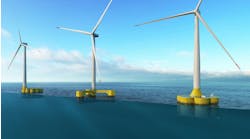Offshore staff
LONDON — Britain’s North Sea Transition Authority (NSTA) has published the reports of the three winners of its Platform Electrification competition launched last September.
This secured funding of £1 million ($1.22 million) from the U.K. government as part of the North Sea Transition Deal (NSTD) signed by the government and the oil and gas industry in 2021.
It commits the industry to reduce its U.K. offshore emissions by 50% in 2030, equivalent to CO2 cuts of 2 MMt/year to 3 MMt/year.
NSTA is working with industry representatives to progress offshore electrification projects and with the BEIS-chaired Government and Regulators Electrification Group on the wider policy and regulatory conditions that will also need to be in place.
The three winning studies demonstrated concepts that do not require power from shore, instead developing standalone power systems using renewable power, although they can potentially be supported by power cables from the shore.
All suggest emissions reductions of 78% to 87% are attainable, NSTA added.
Microgrid electrification concept
Orcadian Energy and partners Crondall, Enertechnos, NSMP, Petrofac and Wärtsilä have developed the Microgrid electrification concept, based on standardized offgrid floating power distribution hubs, which could receive power from floating offshore wind farms. These would be combined with low-emission backup power generation to ensure a low-emission continuous power supply to offshore oil and gas installations.
Each power distribution hub is located close to the receiving installations to minimize the length of the power distribution cables. The solution is phased and scalable, and it is said to be applicable to multiple regions of the U.K. Continental Shelf.
Project Neos electrification
Ørsted, Neptune Energy and Goal 7’s Project Neos concerns electrification of offshore oil and gas assets using renewable offshore wind energy. This pre-FEED study investigated the technical and commercial aspects of an electrical connection between an offshore wind farm and an offshore oil and gas installation without a connection from shore.
Project Neos considered two technical concepts, using subsea cables and assessing the feasibility in terms of power availability and reliability. The partners also assessed the design modifications required at the oil and gas installation and the need for an offshore microgrid, including backup power generation, energy storage and advanced control to stabilize the switch from renewable power to backup power.
Other issues covered included the maximum capex related to infrastructure upgrades, and sensitivities to gas, electricity and carbon prices.
Offshore electricity distribution network
The third winner was Katoni Engineering’s optimized method for interfacing distributed sources of renewable generation with existing offshore oil and gas installations requiring secure sources of low-emissions power.
The study designed an optimized offshore electricity distribution network said to minimize the cost of brownfield platform modifications through delivering power at, or close to, current platform power voltages.
The network includes backup power generation situated on a floating electrical distribution hub to ensure power continuity in the offgrid electrical network design. Katoni designed the power distribution based on a power clustering methodology that could cover electrification of about 20 platforms in much of the U.K. central North Sea.
06.23.2022



